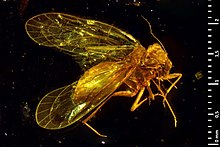Compsocidae
| Compsocidae Temporal range:
| |
|---|---|

| |
| Burmacompsocus perreaui | |
| Scientific classification | |
| Kingdom: | Animalia |
| Phylum: | Arthropoda |
| Class: | Insecta |
| Order: | Psocodea |
| Suborder: | Troctomorpha |
| Infraorder: | Amphientometae |
| Family: | Compsocidae |
| Genera | |
| |
Compsocidae is a family of Psocodea (formerly Psocoptera) belonging to the suborder Troctomorpha.[1] The family comprises two extant species in two genera, both found in Mesoamerica. Compsocus elegans is found in Mexico and Central America, while Electrentomopsis variegata is found in Mexico.[2] The antennae of each species have 13 or 14 segments. Two extinct genera, and are known from the Cenomanian aged Burmese amber of Myanmar.
Taxonomy[]
- Compsocus Banks, N., 1930[3]
- Compsocus elegans Banks, N., 1930
- Electrentomopsis Mockford, 1967[4]
- Electrentomopsis variegata Mockford, 1967
- †Burmacompsocus Nel & Waller, 2007[5]
- Burmacompsocus banksi (Cockerell, 1916)[6] (originally Psyllipsocus)
- Burmacompsocus coniugans Sroka & Nel, 2017[7]
- Burmacompsocus perreaui Nel & Waller, 2007
- Burmacompsocus pouilloni Ngô-Muller et al. 2020[8]
- †Paraelectrentomopsis Azar, Hakim & Huang, 2016[9]
- Paraelectrentomopsis chenyangcaii Azar, Hakim & Huang, 2016
References[]
- ^ Johnson, Kevin P.; Smith, Vincent S. (2021). "Psocodea species file online, Version 5.0". Retrieved 2021-11-05.
- ^ "Compsocidae". Tree of Life Project. Retrieved 30 June 2018.
- ^ Banks, Nathan (1930-01-01). "Some New Neotropical Neuropteroid Insects". Psyche: A Journal of Entomology. 37 (2): 183–191. doi:10.1155/1930/89823. ISSN 0033-2615.
- ^ Mockford, Edward L. (1967-01-01). "The electrentomoid psocids (Psocoptera)". Psyche: A Journal of Entomology. 74 (2): 118–165. doi:10.1155/1967/862560. ISSN 0033-2615.
- ^ Nel, A.; Waller, A. (December 2007). "The first fossil Compsocidae from Cretaceous Burmese amber (Insecta, Psocoptera, Troctomorpha)". Cretaceous Research. 28 (6): 1039–1041. doi:10.1016/j.cretres.2007.02.002. ISSN 0195-6671.
- ^ Cockerell, T. D. A. (1916-08-01). "Insects in Burmese amber". American Journal of Science. s4-42 (248): 135–138. Bibcode:1916AmJS...42..135C. doi:10.2475/ajs.s4-42.248.135. ISSN 0002-9599.
- ^ SROKA, PAVEL; NEL, ANDRÉ (2017-09-18). "New species of Compsocidae (Insecta, Psocodea) from Cretaceous Burmese amber". Zootaxa. 4320 (3): 597. doi:10.11646/zootaxa.4320.3.12. ISSN 1175-5334.
- ^ Ngô-Muller, Valerie; Garrouste, Romain; Nel, André (June 2020). "Small but important: A piece of mid-Cretaceous Burmese amber with a new genus and two new insect species (Odonata: Burmaphlebiidae & 'Psocoptera': Compsocidae)". Cretaceous Research. 110: 104405. doi:10.1016/j.cretres.2020.104405. ISSN 0195-6671.
- ^ Azar, Dany; Hakim, Marina; Huang, Diying (December 2016). "A new compsocid booklouse from the Cretaceous amber of Myanmar (Psocodea: Troctomorpha: Amphientometae: Compsocidae)". Cretaceous Research. 68: 28–33. doi:10.1016/j.cretres.2016.08.003. ISSN 0195-6671.
Sources[]
- Lienhard, C. & Smithers, C. N. 2002. Psocoptera (Insecta): World Catalogue and Bibliography. Instrumenta Biodiversitatis, vol. 5. Muséum d'histoire naturelle, Genève.
Categories:
- Psocoptera families
- Troctomorpha
- Psocoptera stubs